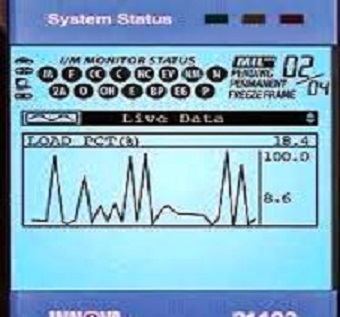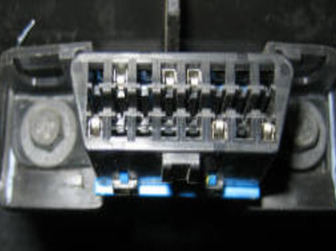
Interpretation of scan tool data for most do-it-yourself driveway mechanics is a simple matter of retrieving the code and identifying what the code means.
This can not only point you in the right direction, but is also considered by many professional technicians as the first step in a logical path of diagnosis.
When a check engine light comes on you should connect an OBD II scan tool and hit the read button. In most cases you’ll be retrieving the set trouble code and identifying the system the failure is in.
It also makes sense to clear it and take a test drive to see if the light returns setting the same one. This confirms a hard failure or an intermittent one. If you own an advanced OBD II auto scan tool you can also check for pending codes.
Pending codes are sometimes called history codes. No matter what you call them, these failures are set in memory, but have not met the criteria to notify the driver by turning on the warning light.
You might also want to pull up the data stream for the sub system showing the failure and review the information in real time. And this is what this page is about.
Learn how to use the scan tool data stream to identify failed components. I have more about inexpensive scanners I own that can read the data stream at my automotive scan tool review page.
OBDII Scan Tool Data Examples
Lets say a particular automobile sets a code for a coolant temperature sensor malfunction of some kind. You can then read the scan tool data for the coolant temperature circuit in real time.
You will be able to monitor the coolant temperature in Fahrenheit and the change in sensor voltage. If the vehicle is cold you can start it up and let it run.
Watch the coolant temperature volts rise slow and steady on the scan tool and look for problems. This verifies the correct operation of the sensor and the integrity of the wiring between the computer and the sensor.
If the coolant temperature and voltage remains at a fixed value, yet the vehicle continues to warm up, you may have a dead coolant temperature sensor or bad wiring between the sensor and the computer.
Reading scan tool data gives you insight on what the failure might be. When the dreaded check engine light comes on and the vehicle sets a specific code you can then pull up the data stream for that system on the obd II automotive scanner.
Just because the computer sets a code for a specific sensor doesn’t automatically indicate the sensor has failed. More often than not the sensor is working correctly and making you aware of a problem with the vehicle.
I have an example about the commonly misdiagnosed O2 sensor code. Another example is the a temperature sensor mentioned above. If we set a coolant sensor code and the voltage increases as the vehicle warms up, the sensor is working correctly.
In this scenario the code represents a mechanical failure in the coolant system not an electrical issue with a sensor. Maybe this code set because of a a stuck thermostat causing an overheating condition. Or even a stuck open thermostat not allowing the vehicle to reach its proper operating temperature.
Reading the Scan Tools Data Stream
Reading scan tool data can put you a clear path of diagnosis. The best way to approach the repair of a vehicle that set a diagnostic code is to use the scanner in combination with a quality repair manual.
The online auto repair manual will provide step-by-step diagnostic and troubleshooting procedures with component location diagrams for that particular failure code on that specific automobile.
Mechanics call these paper tools tree charts or ladder diagrams. They are issued from the factory for complex diagnosis. Using these tools together can save you a lot of time and money in replacing unnecessary auto parts.

The OBD II scan tool is very easy to use in my opinion. In most cases and on the majority of automobiles you will find the on board diagnostic connector just left of and below the steering column.
The exact location is usually pointed out in the owners manual as well. After finding the connector simply plug in the diagnostic tool and begin reading the scan tool data. Most scan tools come with paper manuals or discs that provide a good knowledge base for beginner diagnosis.
On board diagnostic second generation scan tools like the Actron 9680 above, or the Innova 3030g now have color screens. Thanks to the power of competition between the two companies the price has come down a lot over the last few years.
Reading scan tool data has become much easier also, thanks to the OBD II standardized protocols. What is cool about the Actron and why it costs more is it has a Code-Connect button on the keypad that lists probable solutions according to the data on file.
However, both tools are compatible with OBD-II and CAN vehicles 1996 and newer. Both include foreign and domestic code coverage, but the Actron also reads ABS codes on some vehicles. It also has a snap shot mode where it records and can playback information on screen.
If you learn how to read and use a scan tool on your own car you can use the same exact technique on many cars 1996 and up. My advice is to be the envy of your neighborhood and teach yourself how to read scan tool data. It is a language worth learning.
Service engine soon lights pop on all the time, because the systems are so sensitive. Why not be the go to guy for when this common problem occurs? Reading through my other pages on my auto scan tool homepage is a great place to start.
Give this Automobile problem solving page a share or bookmark it.
I posted a short video about using online auto repair programs to fix cars at home. See the clip and my pick for best online auto service manual.
The next link takes you to more articles written on the check engine light subject. See how to use auto scan tools to fix complex car problems.
Are you looking for the worlds least expensive car code reader? Well here are two really cheap auto scan tools. Learn more about me and this car website on the auto facts.org homepage. Interact with the us and see what you can find here.
